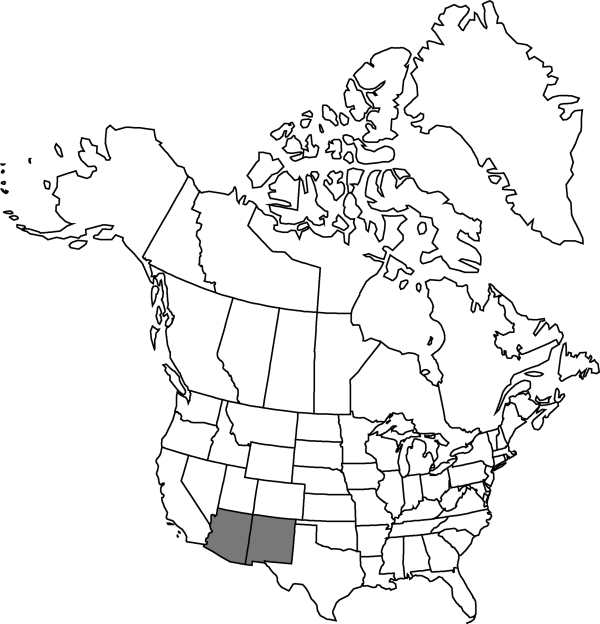Difference between revisions of "Phemeranthus validulus"
Novon 11: 321. 2001.
Basionym: Talinum validulum Greene
FNA>Volume Importer |
FNA>Volume Importer |
||
| Line 19: | Line 19: | ||
}}<!-- | }}<!-- | ||
| − | --><span class="statement" id="st- | + | --><span class="statement" id="st-undefined" data-properties=""><b>Plants </b>to 1.2 dm; roots elongate, woody. <b>Stems</b> spreading-ascending overall, sometimes basally decumbent, branching. <b>Leaves</b> sessile; blade terete, to 4.5 cm. <b>Inflorescences</b> cymose, slightly to much overtopping leaves; peduncle ± scapelike or not, to 6.5 cm. <b>Flowers</b>: sepals persistent, broadly lanceolate, to 4 mm, apex acuminate; petals white to purplish pink, paler at base, elliptic-ovate, to 9 mm; stamens (6–)7–18; stigma 1, subcapitate, sometimes 3-lobed. <b>Capsules</b> ovoid, strongly trigonous, 5–7 mm. <b>Seeds</b> without arcuate ridges, 1 mm.</span><!-- |
-->{{Treatment/Body | -->{{Treatment/Body | ||
| + | |phenology=Flowering Jun–Sep. | ||
|habitat=Woodland openings and bare slopes and summits in rocky soil on chert, basalt, and cinder | |habitat=Woodland openings and bare slopes and summits in rocky soil on chert, basalt, and cinder | ||
|elevation=1800-2400 m | |elevation=1800-2400 m | ||
| Line 41: | Line 42: | ||
|basionyms=Talinum validulum | |basionyms=Talinum validulum | ||
|family=Portulacaceae | |family=Portulacaceae | ||
| + | |phenology=Flowering Jun–Sep. | ||
|habitat=Woodland openings and bare slopes and summits in rocky soil on chert, basalt, and cinder | |habitat=Woodland openings and bare slopes and summits in rocky soil on chert, basalt, and cinder | ||
|elevation=1800-2400 m | |elevation=1800-2400 m | ||
| Line 48: | Line 50: | ||
|publication year=2001 | |publication year=2001 | ||
|special status= | |special status= | ||
| − | |source xml=https://jpend@bitbucket.org/aafc-mbb/fna- | + | |source xml=https://jpend@bitbucket.org/aafc-mbb/fna-data-curation.git/src/9216fc802291cd3df363fd52122300479582ede7/coarse_grained_fna_xml/V4/V4_1009.xml |
|genus=Phemeranthus | |genus=Phemeranthus | ||
|species=Phemeranthus validulus | |species=Phemeranthus validulus | ||
| − | |||
| − | |||
| − | |||
| − | |||
| − | |||
| − | |||
| − | |||
| − | |||
| − | |||
| − | |||
| − | |||
| − | |||
| − | |||
| − | |||
| − | |||
| − | |||
| − | |||
| − | |||
| − | |||
| − | |||
| − | |||
| − | |||
| − | |||
| − | |||
| − | |||
| − | |||
| − | |||
| − | |||
}}<!-- | }}<!-- | ||
-->[[Category:Treatment]][[Category:Phemeranthus]] | -->[[Category:Treatment]][[Category:Phemeranthus]] | ||
Revision as of 13:55, 27 July 2019
Plants to 1.2 dm; roots elongate, woody. Stems spreading-ascending overall, sometimes basally decumbent, branching. Leaves sessile; blade terete, to 4.5 cm. Inflorescences cymose, slightly to much overtopping leaves; peduncle ± scapelike or not, to 6.5 cm. Flowers: sepals persistent, broadly lanceolate, to 4 mm, apex acuminate; petals white to purplish pink, paler at base, elliptic-ovate, to 9 mm; stamens (6–)7–18; stigma 1, subcapitate, sometimes 3-lobed. Capsules ovoid, strongly trigonous, 5–7 mm. Seeds without arcuate ridges, 1 mm.
Phenology: Flowering Jun–Sep.
Habitat: Woodland openings and bare slopes and summits in rocky soil on chert, basalt, and cinder
Elevation: 1800-2400 m
Discussion
The more recently described Phemeranthus thompsonii may be indistinct from P. validulus and perhaps should be merged with it.
Selected References
None.
Lower Taxa
None.
